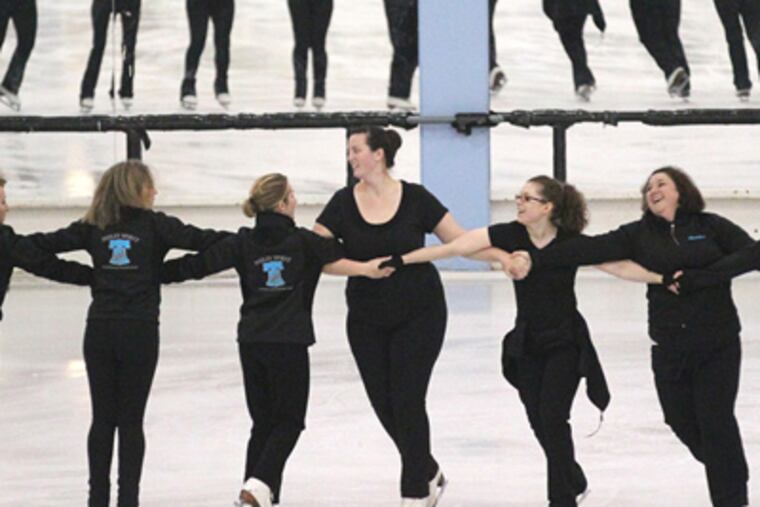Aging gracefully - as synchronized skaters with Philly Spirit
Janet Rosen grew up wanting to be Peggy Fleming, but with no money for lessons, she had to settle for teaching herself figure-skating basics at her local rink.

Janet Rosen grew up wanting to be Peggy Fleming, but with no money for lessons, she had to settle for teaching herself figure-skating basics at her local rink.
Years later, when her own two children balked at skating lessons, she realized it was she who should be on the ice, not them.
"They weren't into it, but I was," said Rosen, an enviably trim 54-year-old pathologist who lives in Wynnewood.
When she finally got serious about learning to skate, she was more likely to eat ice than win gold. But more than a decade later, she is the captain of Philly Spirit, the only adult synchronized skating team in the Philadelphia area. The team trains at the Philadelphia Skating Club and Humane Society in Ardmore, which bills itself as the oldest skating club in the nation and has been home to such figure-skating notables as Dick Button and Scott Hamilton.
Performing anything in unison is challenging. Doing it on quarter-inch blades at high speeds with a dozen other people - well, that's synchronized skating, or "synchro skating" for short. Think of it as the Rockettes on a very slippery surface.
Nationwide, synchronized skating is the fastest-growing discipline within figure skating, according to the U.S. Figure Skating Association.
On a competitive level, the sport gained traction in the mid-1980s, when the United States held its first synchronized team skating championships.
In 1997, synchronized skating became a collegiate sport, though only three colleges fielded teams. Currently there are about 50 teams, with more cropping up each season, according to the USFSA.
Like a TV dance competition, synchro skating allows amateurs to fulfill their figure-skating fantasies, right down to the sparkly costumes and choreographed routines.
"It's addictive," said Rosen, who is also a competitive ice dancer.
She joined the team 15 years ago, when it was mostly recreational. The team has since hired professional coaches and last year came in third in the qualifying heat at the Eastern Sectional Synchronized Skating Championships in Lowell, Mass., though it tanked in the finals.
"Even making it that far was a big deal for us," Rosen said.
At a recent practice, the team made it look easy. Its members glided onto the ice to Britney Spears' "Womanizer." After striking an opening pose, the skaters moved into a "block" of three rows, then morphed into a backward spinning circle, a pinwheel, and finally a classic kick line.
"I couldn't do that. My knees couldn't handle it," coach Regina Barr said as she watched. "They're much more fast-paced than they used to be."
They have to be speedy to compete with the kids. The 12 members range in age from 21 to 54. In their division, there is no minimum age, so they are competing against younger, stronger skaters. They would like to be in the masters division, where skaters must be at least 25, but they need more members.
Helping boost their numbers is their other coach, John Thomas, 51, a former Canadian Olympic ice dancer. That he's the only man in the group doesn't make a difference, except for the ribbing he gets from the "girls." The sport is coed and even boasted an all-male team from New York called "Men in Synch."
"I try not to think about it," Thomas said good-naturedly of his unique spot on the team.
"I had nothing else to do with my time," he said deadpan when asked why he joined.
"It was the makeup," joked Rosen.
But seriously, he said, the women hold their own against much younger skaters. In last year's championships, the team had to perform twice in a "skate-off."
"The other seven teams there had younger kids, so we did very well," he said.
For many Spirit members, the biggest challenge is not skill but cost, which can reach several thousand dollars a year for club and team dues, costumes, private lessons, travel, and skates.
Kelly Leahy, 26, of Willow Grove, who grew up skating but put it aside for college and a career as a kindergarten teacher, heard about the team while she was going through a rough patch.
Despite the expense, she knew she had to join.
"It completely put my life back on track," she said. "As soon as I walked into the rink and smelled that smell, I teared up."
Whether that nostalgic scent is, as her teammates laughingly suggested, Zamboni exhaust or mildew, they knew exactly what she was talking about.
"You walk into the rink and there's that smell and you go, 'ahh'," said Sarah Huszar, 27, a neuroscientist from North Wales.
The best part, they say, is the camaraderie, which extends off the ice to barbecues, trips to the beach, and martini nights.
But getting back on skates after years away from the rink can be terrifying. Tish DeStefano, 42, of Drexel Hill, hadn't skated for years when she decided to try out three years ago.
"I was scared to death," she said. "There's a very big difference between skating and synchro skating."
That's true, said Rosen.
"There's confidence in numbers," she said, "but you can also get someone's blade in your face."
Contact staff writer Kathy Boccella at 610-313-8123 or kboccella@phillynews.com.